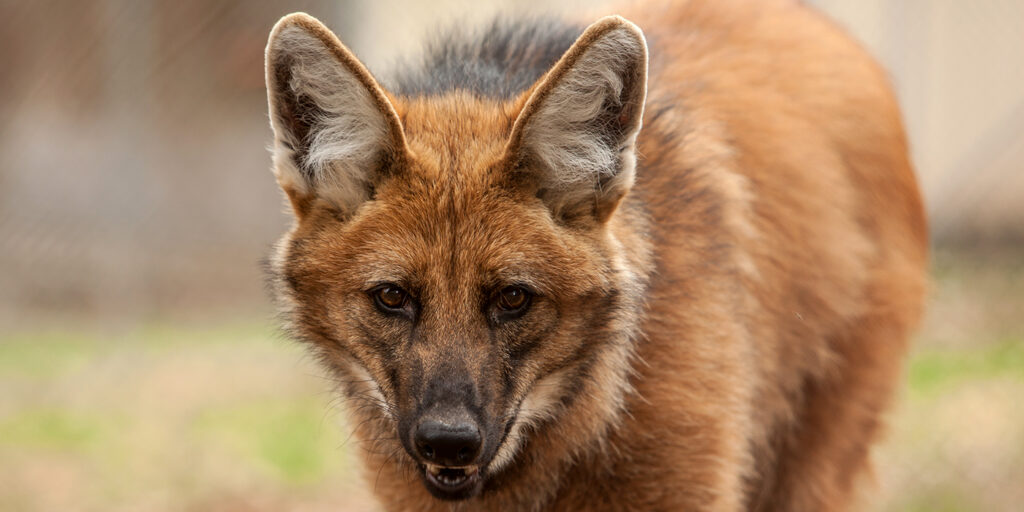1. Maned Wolf
The Maned Wolf (Chrysocyon brachyurus) is one of the most extraordinary mammals in South America. Despite its name, it is not a true wolf nor a fox, but a distinct species in its own genus, Chrysocyon, meaning “golden dog.”
Famous for its long legs and reddish fur, the Maned Wolf roams the grasslands and savannas of Brazil, Paraguay, Bolivia, Argentina, and Peru. Its graceful appearance and elusive nature make it one of the most fascinating predators of the continent.
2. Physical Description
The Maned Wolf is the tallest wild canid in the world, standing up to 90 cm (35 inches) at the shoulder and weighing between 20-30 kg (44-66 lbs).
Its long, slender legs are an adaptation to life in tall grass, allowing it to see above vegetation while hunting. The reddish coat, dark mane, and white-tipped tail give it a striking and elegant look.
When threatened or alarmed, the wolf raises its black mane along the neck an intimidating display that inspired its name.
ALSO SEE : The Baobab Tree (Adansonia digitata): Africa’s Ancient “Tree of Life”
3. Habitat and Distribution
This species thrives in open habitats, including cerrado grasslands, scrub forests, and marshy plains.
The Brazilian Cerrado, one of the most biodiverse ecosystems on Earth, serves as its main stronghold.
Unfortunately, rapid agricultural expansion and urbanization have caused severe habitat fragmentation, pushing the species into smaller, isolated populations.
4. Behavior and Diet
The Maned Wolf is a solitary and nocturnal animal, active mainly during dusk and dawn.
Unlike most canids, it is omnivorous its diet consists of both meat and fruit.
It hunts small mammals, birds, reptiles, and insects, but one of its favorite foods is the wolf apple (Solanum lycocarpum), a fruit that helps with digestion and parasite control.
This balanced diet plays an important ecological role by dispersing seeds and maintaining the natural cycle of its environment.
5. Reproduction and Life Cycle
The breeding season occurs between April and June. Females give birth to two to five pups after a gestation of around 65 days.
Both parents share responsibility for feeding and protecting the pups until they become independent after about one year.
Maned Wolves are known for their distinctive, high-pitched roar-bark, which can be heard over long distances and is used for communication between individuals.

6. Conservation Status and Threats
According to the International Union for Conservation of Nature (IUCN), the Maned Wolf is listed as Near Threatened.
Major threats include:
- Deforestation and agricultural expansion destroying its habitat.
- Road accidents and collisions with vehicles.
- Poaching due to false beliefs and superstitions.
- Diseases transmitted by domestic dogs.
Several conservation initiatives in Brazil and Argentina focus on habitat protection, public education, and vaccination programs to reduce disease risks.
7. Interesting Facts
- The Maned Wolf’s urine has a strong, musky odor similar to cannabis, earning it the nickname “skunk wolf.”
- Despite its wolf-like appearance, genetic studies show it is closer to ancient South American canids.
- It uses its long legs to “stalk and pounce” on prey like a fox rather than chase like a wolf.
- It plays a vital role in maintaining healthy grassland ecosystems.
8. Conclusion
The Maned Wolf is a symbol of the South American wilderness graceful, solitary, and deeply connected to its environment. Protecting its natural habitat is essential not only for this unique species but also for the balance of the entire Cerrado ecosystem.
Through conservation, research, and education, we can ensure that this remarkable animal continues to roam the golden grasslands of South America for generations to come.
ALSO SEE : Modular and Prefabricated Construction: The Future of Smart, Efficient Building





